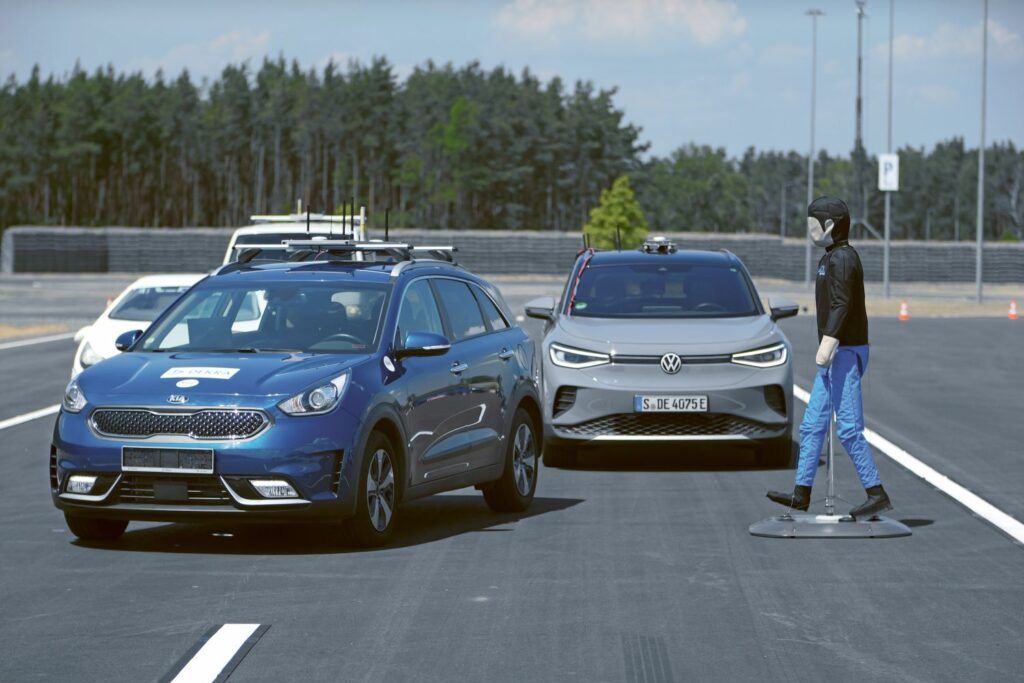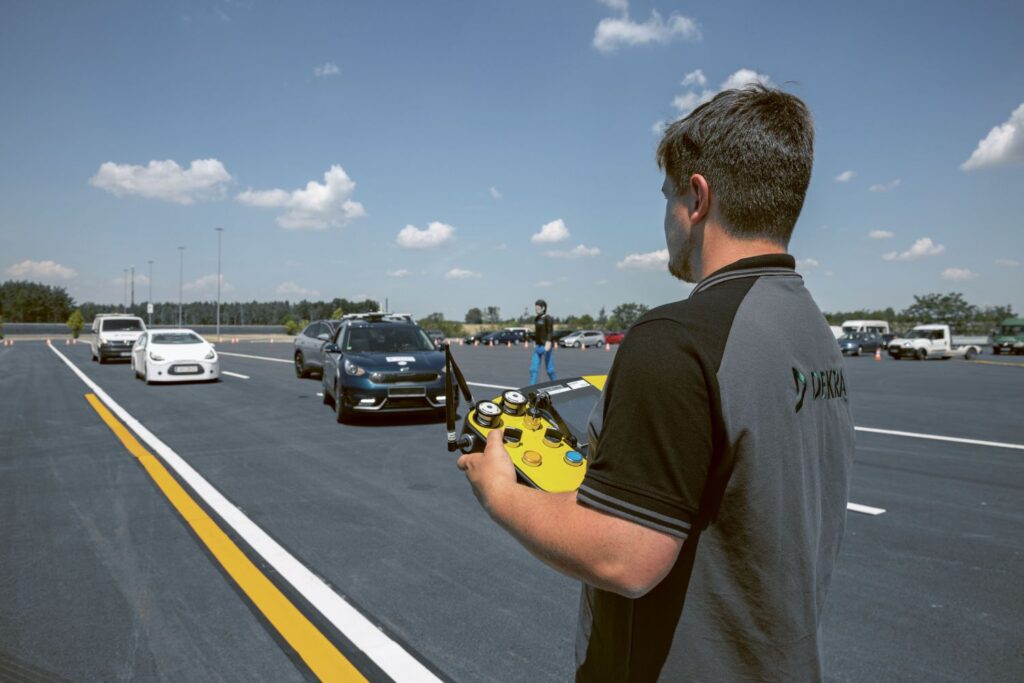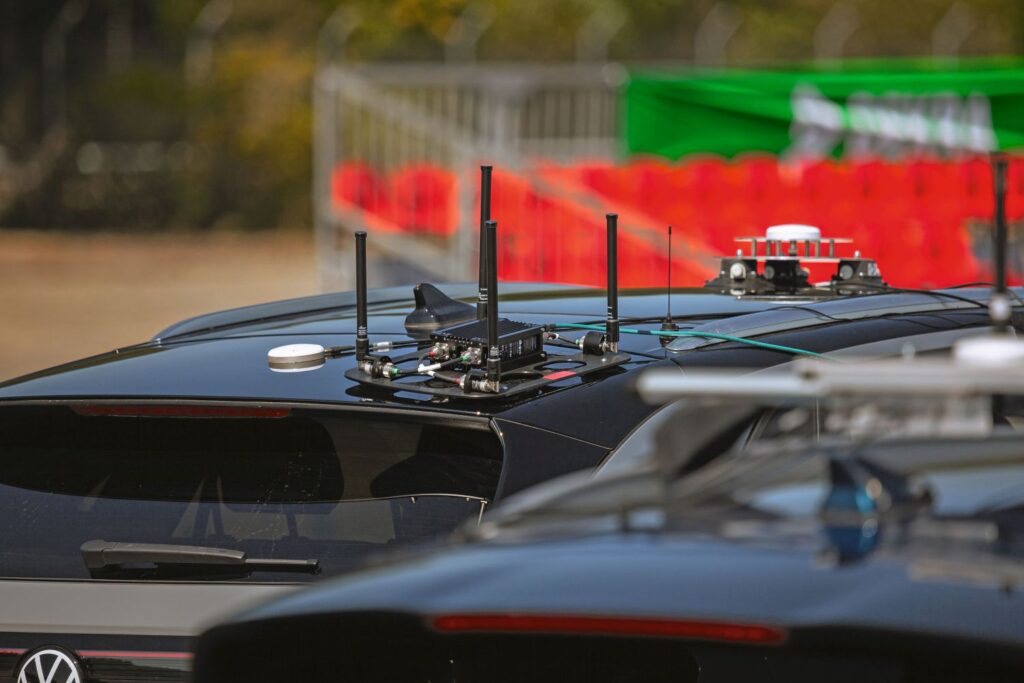Automated, but Safe!
Author: Matthias Gaul
At the Lausitzring in Klettwitz, Germany, DEKRA puts assistance systems and automated vehicle technologies through their paces, most recently also in urban environments on specially established city courses. These tests are of central importance – because acceptance by society depends on the safety and reliability of the systems.
We sped off without anyone holding the wheel, whizzing around corners, dodging other equally fine motorcars, no one honking. […] Instead of the steering wheel, I found a metal plate with the city map etched very finely and clearly on it. Above it a needle-sharp cursor. No sooner had I shifted that cursor a little than the car started up and shot through streets I didn’t yet know. Just as suddenly it stopped. […] The most wonderful thing about it was that the car avoided other vehicles, stopped suddenly before busy intersections, let other cars pass, and behaved as if it had memorized every conceivable traffic regulation.”
Anyone reading these lines from Werner Illing’s science fiction novel “Utopolis”, published in 1930, may find it hard to believe the way in which the German writer was already anticipating what vehicle manufacturers are working hard on today. Especially since, in the further course of his novel, he also addresses the topic of connectivity in regard to the technical functionality of the “mysteriously self-steering cars”: Each car has “a small prismatic eye” at the front that acts on light-sensitive electrical cells and communicates with electrical eyes that are “inconspicuously embedded in the walls of houses”. “Through changing mirror reflections, these mechanical eyes regulate speed and steering.”
93 years later, with the increasing digitization of traffic, society is on the threshold of what is probably the greatest mobility revolution since the invention of the automobile. Software and electronics are taking over more and more tasks and turning cars into rolling high-tech machines. All major manufacturers now offer assisted and semi-automated driving, and the number of vehicles with automated driving functions will increase significantly in the coming years.
Whether it is automatic lane keeping, acceleration and braking adapted to the surrounding traffic conditions, emergency braking at the end of a traffic jam, or automated emergency braking when turning right, to name just a few examples: Driver assistance systems can detect critical traffic situations at an early stage, warn of dangers, and also actively intervene if necessary. “All of the individual systems have the potential to prevent accidents or at least mitigate the consequences of accidents,” emphasized Jann Fehlauer, Managing Director of DEKRA Automobil GmbH, at the presentation of the DEKRA Road Safety Report 2023 in Berlin, titled “Technology and People”. At the same time, Fehlauer pointed out that over 90 percent of traffic accidents occur because people make mistakes. It is therefore important to compensate for these mistakes as efficiently as possible, for example by providing electronic assistance. After all, the suffering involved is immense: Worldwide, the World Health Organization estimates the number of annual traffic fatalities at around 1.3 million.


Complex test scenarios
One thing is clear: Before approval and series production, assistance systems must be put through their paces and evaluated extensively to ensure that they function in the best possible way. This is precisely what happens at the DEKRA Technology Center at the Lausitzring in Klettwitz, Brandenburg, Germany, among other places. This is where, over the last few years, the expert organization has created Europe’s largest independent test site for automated and connected driving covering an area of around 550 hectares in total. The latest milestone was the inauguration of special city courses at the end of June 2023 to test automated driving functions in urban environments as realistically as possible.
For this purpose, they installed around 80,000 square meters of variable-use asphalt surfaces. The system includes lanes, large areas, intersection areas, and even tram tracks. With flexible markings, mobile infrastructure, and situational perimeter development, it is now possible to display a wide variety of scenarios for inner-city and, in some cases, intercity traffic. The concrete layout of the asphalt surfaces of the new city courses was planned by DEKRA in a joint working group with vehicle manufacturers, suppliers, and research institutions. “Under the leadership of the Fraunhofer Institute for Traffic and Infrastructure Systems in Dresden, we evaluated the inner-city and suburban accident history in Germany from 2013 to 2019 in detail,” explains Uwe Burckhardt, Head of Test and Event at DEKRA Lausitzring. With the road geometries of the flexible city courses, more than 80 percent of these real traffic scenarios can be reproduced in the test.
Reproducibility in tests can validate simulations
“Using state-of-the-art technology, we can put vehicles in almost any complex situation to expose their automated driving functions to the maximum test challenge,” Burckhardt goes into detail. In so-called swarm tests, up to twelve moving objects could be used in the test vehicle’s environment. For this purpose, data exchange between the control station and the targets must take place in real time or with very low latency – preferably via the 5G communication standard. These objects can represent a wide variety of other vehicles as well as pedestrians and can be controlled with centimeter precision by using, among other things, the Differential Global Positioning System. This means that the same test sequences can be reproduced again and again, so that systems and functions can be tested under the same conditions in each case. For example, the reaction of an emergency brake assistant to the end of a traffic jam or a pedestrian suddenly crossing the road, the behavior of a turn-off assistant with a cyclist in the driver’s blind spot, or the reliability of highly and fully automated and autonomous systems, to name just a few examples.
Reproducibility is, in fact, a very important keyword in this context. “In order to achieve representative and statistically reliable results in endurance tests in real traffic, it’s necessary to drive distances of many millions of kilometers,” explains Burckhardt. And cameras and sensors have to prove themselves in around 15,000 individual tests before they can be installed in a production vehicle. This is hardly economically feasible. Therefore, as many situations as possible have to be simulated in computer systems under a wide range of boundary conditions. The better the simulation systems are matched to real conditions, the better the results they deliver. It must also be possible to recreate situations that produce critical results in the simulation as reproducibly as possible in reality.
That is why it is a great advantage for developers in the automotive and supplier industry if such simulations can be carried out on the basis of specific road data, on which the tests are later also reproduced in practice. And exactly this is possible with the DEKRA Lausitzring’s terrain model and surrounding test tracks. For this purpose, DEKRA had the entire test site extensively digitized using a 3D laser scan. Based on this, a 3D terrain model was developed, which optimally serves the specific planning of tests to validate functions of highly automated driving.
Further expansion being planned
As things stand, the test tracks at the Lausitzring cover almost all the so-called “operational design domains” of automated driving – in other words, the environments for which automated driving functions will be designed in the future. In addition, the site is also used for NCAP scenarios to evaluate the safety of passenger cars. But development does not end there. “We also want to close the last gaps soon, and suitable plans for further test tracks are already being made,“ says Erik Pellmann, Division Manager Technology Center at DEKRA Automobil GmbH. “It is our goal to also be able to simulate specific weather conditions on certain routes.” In the foreseeable future, special overland routes could be built on the site, on which automated driving systems could then be tested in a typical country road environment. The perfect complement to the high-speed area and city courses. “Automated and networked functions will permanently change the vehicles and mobility of tomorrow,” says Pellmann. DEKRA is setting an important course with its tests of automated driving functions in Klettwitz and also networked functions in Málaga, Spain.
System security important for high acceptance
The importance of such tests cannot be overstated. After all, as the DEKRA Road Safety Report 2023 mentioned at the beginning of this article points out, there is a great danger that trust in the respective automated driving function or driver assistance system will decline if it makes too many errors. A warning function that is set too sensitively, for example, and constantly provides feedback to the driver or triggers too many false alarms is quickly perceived as annoying or bothersome. This reduces acceptance or the willingness to delegate the responsibility of control to the system. “When the technology reaches its limits, it can also happen with increasing levels of automation that the driver disengages from the automation and takes over manual control again,” DEKRA traffic psychologist Dr. Thomas Wagner points out. Studies from the USA have shown that more than 80 percent of such “disengagements” were initiated by drivers who either felt uncomfortable with the maneuvers of the automated vehicles or carried out manual disengagements as a precaution due to insufficient trust.
Wagner sees a further problem with highly automated driving in the fact that difficulties could arise when the person at the wheel of a car should be taking control. This is particularly the case when the driver is reading a newspaper or using a smartphone or tablet during the highly automated journey. DEKRA has already conducted a comprehensive study on this topic at the Lausitzring in cooperation with the Technical University of Dresden. One of the results was that the performance of a secondary task – insofar as it requires the same kind of visual-cognitive resources as conventional driving – makes it very difficult to recognize system-related errors during automated vehicle control and to react promptly and appropriately to the situation. Despite all the euphoria about the temptations of digitization in the brave new automotive world, we have to hope that the technology will not come at the expense of the “human factor” but will actually contribute to a large extent to the desired goal: reducing the number of accidents in the spirit of “Vision Zero”.
Technology and People
Technological progress through assistance systems or automated vehicle technologies undoubtedly offers the potential for greater safety. At the same time, however, we must keep in mind that the ever- higher degree of automation further increases the system complexity, and that people may only be able to control the technology to a limited extent. It is therefore all the more important to take into account the entire mobility system and the mutual impact dynamics, but above all the reorganization of the driver’s role in the human-machine-environment control loop. At the different stages of assisted driving, technology is supposed to support drivers by providing information, warnings, or mechanical control to help them master their driving task without placing an additional burden on them or limiting their responsibility.
To do this, however, the drivers must know how the driver assistance systems (DAS) and automation levels work, as well as know their limits, and be committed to using them as intended. The DEKRA Road Safety Report 2023, titled “Technology and People”, addresses precisely this dynamic and provides analyses as well as recommendations for action for safe mobility today and in future. It is available at
https://www.dekra-roadsafety.com/en/archive/



